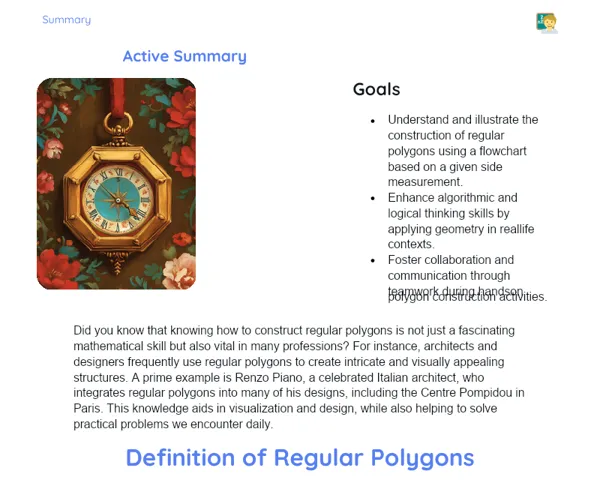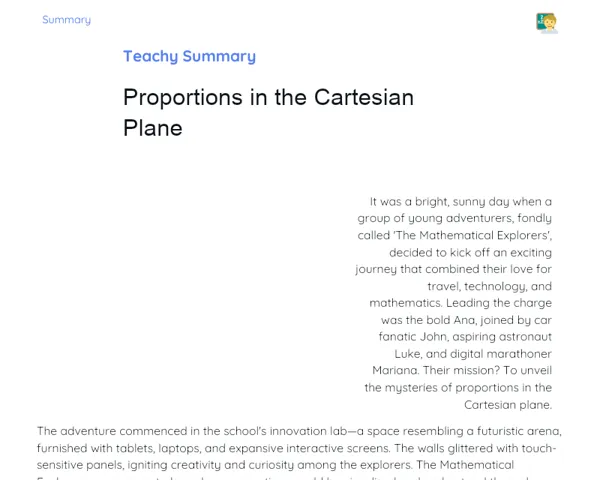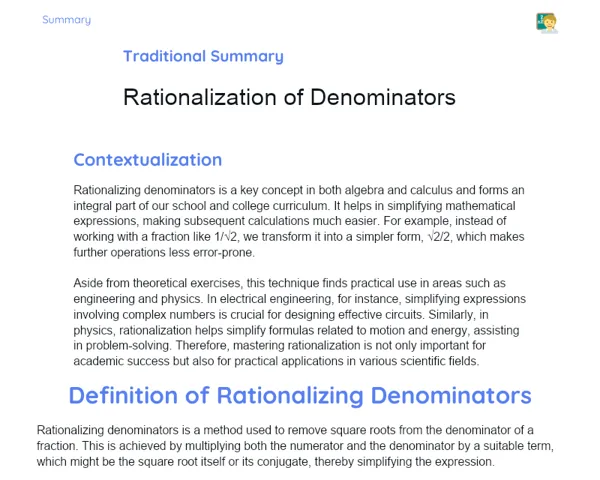Summary Tradisional | Spatial Geometry: Fundamentals
Contextualization
Spatial Geometry is a key branch of mathematics that deals with the study of shapes and their properties in three-dimensional space. To truly grasp this subject, it is important to begin with its most basic elements: the point, the line, and the plane. These are the very building blocks that form the entire geometric structure we are about to explore. For instance, when an architect designs a building, they must know how points come together to form lines and how these lines can intersect or lie within planes. Such understanding is vital for ensuring both precision and safety in design.
Even though Euclid formulated his postulates over two thousand years ago, they still serve as the backbone for most of the geometry we use today. These simple yet powerful principles help us explain the relationships among points, lines, and planes. Not only do they assist in solving mathematical problems, but they also find practical use in areas like Engineering and Architecture. Throughout this lesson, we will delve into these fundamental concepts and their practical applications, preparing ourselves to face more complex challenges in geometry and related fields.
To Remember!
Point
A point is considered the smallest unit in geometry. It does not have dimensions, meaning it lacks length, width, and height. Essentially, it marks a position in space and is usually denoted by an uppercase letter like A, B, or C.
In practical terms, you can think of a point as a small dot on paper or a specific location in three-dimensional space. For example, in Cartesian coordinates, a point in the plane is identified by a pair of numbers (x, y), while in 3D space, it is represented by a set of three numbers (x, y, z).
Although it may seem very simple, understanding a point is crucial because it forms the basis for constructing more complex geometric figures, such as lines and planes. Every geometric object is ultimately made up of points arranged in a particular fashion.
-
A point is the smallest unit of geometry, lacking dimensions.
-
It is denoted by an uppercase letter.
-
In Cartesian coordinates, it is represented as (x, y) in a plane and (x, y, z) in three-dimensional space.
Line
A line is an endless straight path that extends through at least two points. Unlike a line segment, it has no definite beginning or end and stretches infinitely in both directions. Being one-dimensional, it has only length.
In most geometric representations, a line is denoted by a lowercase letter or by naming two points on it, such as line AB. In Cartesian coordinates, a line can be described by an equation like y = mx + b, where m represents the slope and b the y-intercept.
Lines serve as the foundation for defining other geometric shapes and for understanding how points and planes are interrelated. They may run parallel to each other, cross each other at right angles, or meet at some other angle, depending on their slopes and positions.
-
A line is infinite and passes through at least two points.
-
It is one-dimensional, having only length.
-
It can be denoted by a lowercase letter or by two points defining it.
Plane
A plane is a flat, two-dimensional surface that extends infinitely in all directions. It can be defined by three non-collinear points or by a combination of a line and a point not on that line. In geometry, a plane is often represented by a Greek letter, for instance, π.
You can easily imagine a plane as the flat surface of a table or a sheet of paper. In three-dimensional space, a plane is often described by an equation like ax + by + cz = d, where a, b, c, and d are constants.
Planes are essential when examining the spatial relationships of various figures and are widely used in practical applications such as architectural design and engineering analysis.
-
A plane is a two-dimensional surface that extends indefinitely.
-
It can be defined by three non-collinear points or by a line with an external point.
-
The equation of a plane in 3D space is given as ax + by + cz = d.
Euclid's Postulates
Euclid's postulates consist of five basic axioms that provide the foundation of Euclidean geometry. These principles, established by Euclid more than two thousand years ago, continue to guide our understanding of the relationships between points, lines, and planes.
The five postulates are as follows: (1) Only one straight line can be drawn through any two distinct points; (2) A line segment can be extended indefinitely; (3) Given any point and distance, one can draw a circle with that point as its center and the given distance as its radius; (4) All right angles are equal; (5) When a line crosses two other lines and the interior angles on one side add up to less than two right angles, the two lines must eventually intersect on that side.
These fundamental axioms not only form the basis for numerous geometric proofs and constructions but also play a crucial role in solving complex problems across Mathematics, Physics, and Engineering.
-
Euclid's postulates are five basic axioms forming the foundation of Euclidean geometry.
-
They elucidate the fundamental relationships among points, lines, and planes.
-
They enable us to deduce theorems and solve challenging problems.
Relationships Between Lines and Planes
Understanding the relationships between lines and planes is vital for mastering spatial geometry. Several types of interactions can take place: lines can be parallel, perpendicular, or intersect each other.
Two lines are parallel if they lie in the same plane and never meet, sharing the same slope. Perpendicular lines, on the other hand, intersect at a 90-degree angle; in the Cartesian system, their slopes are negative reciprocals of each other.
When a line crosses a plane, they typically intersect at a single point, unless the line lies entirely within the plane. These observations are not only important for solving theoretical geometric problems but also for practical matters such as designing structures and analyzing trajectories.
-
Two lines are parallel if they lie in the same plane and do not intersect.
-
Perpendicular lines meet at a 90-degree angle.
-
A line may either intersect a plane at one point or lie completely within it.
Key Terms
-
Point: The smallest element in geometry without dimensions, represented by spatial coordinates.
-
Line: An endless path passing through two points, characterized by its one-dimensional nature.
-
Plane: A flat, two-dimensional surface that extends infinitely, defined by three non-collinear points.
-
Euclid's Postulates: Five fundamental axioms that underpin Euclidean geometry.
-
Parallel Lines: Lines in the same plane that never meet.
-
Perpendicular Lines: Lines that cross each other at a 90-degree angle.
Important Conclusions
In this lesson, we have taken a detailed look into the basics of spatial geometry by starting with the essential concepts of a point, a line, and a plane. These elements form the groundwork for all geometric structures and are crucial for tackling both academic problems and real-world challenges. We also saw how Euclid's age-old postulates continue to serve as the basis for many modern geometric theorems and constructions.
Furthermore, our discussion on how lines and planes relate—whether through parallelism, perpendicularity, or intersection—illustrates just how applicable this knowledge is, especially in fields like Engineering and Architecture. Such insights aid us in designing and analysing structures with clarity and precision.
Lastly, we stressed the importance of consolidating these concepts through regular practice, which not only solidifies understanding but also hones problem-solving skills. The study of spatial geometry is therefore indispensable, not just for academic progress, but also for a wide range of practical applications that impact our everyday lives.
Study Tips
-
Revisit the basic concepts of a point, line, and plane, and try visualising them in different scenarios, both in 2D and 3D.
-
Practice problems involving Euclid's postulates and the interactions between lines and planes to strengthen your understanding.
-
Look for real-life examples of spatial geometry in fields like Engineering and Architecture to appreciate the practical significance of these ideas.



